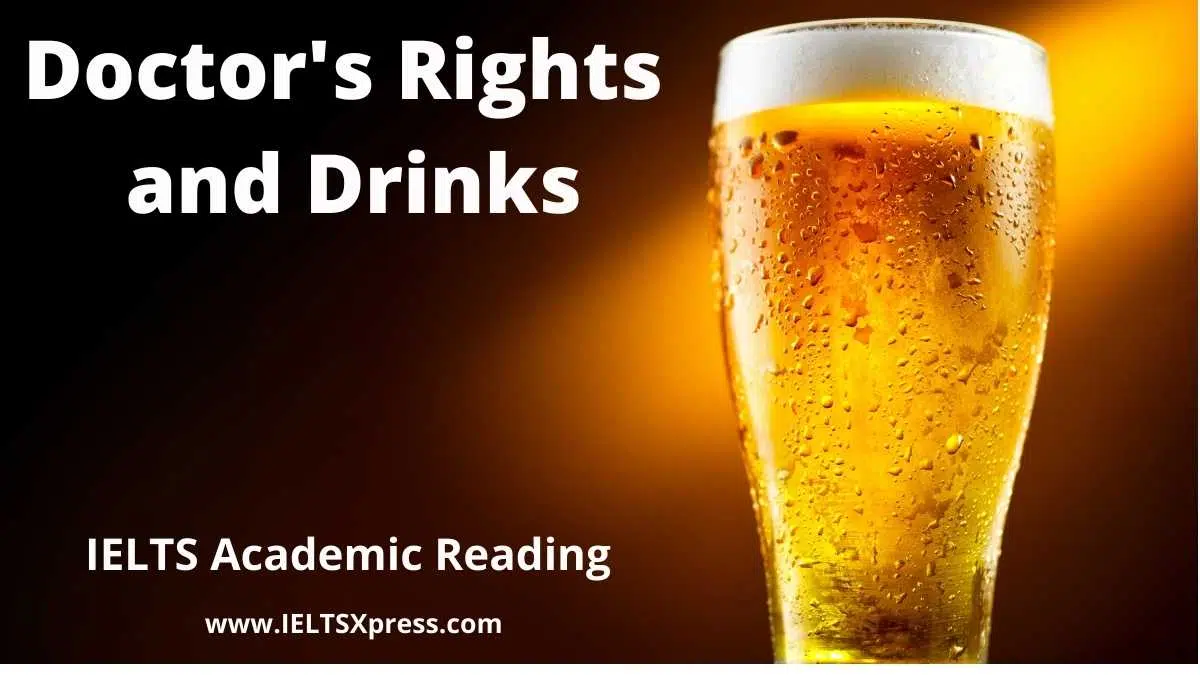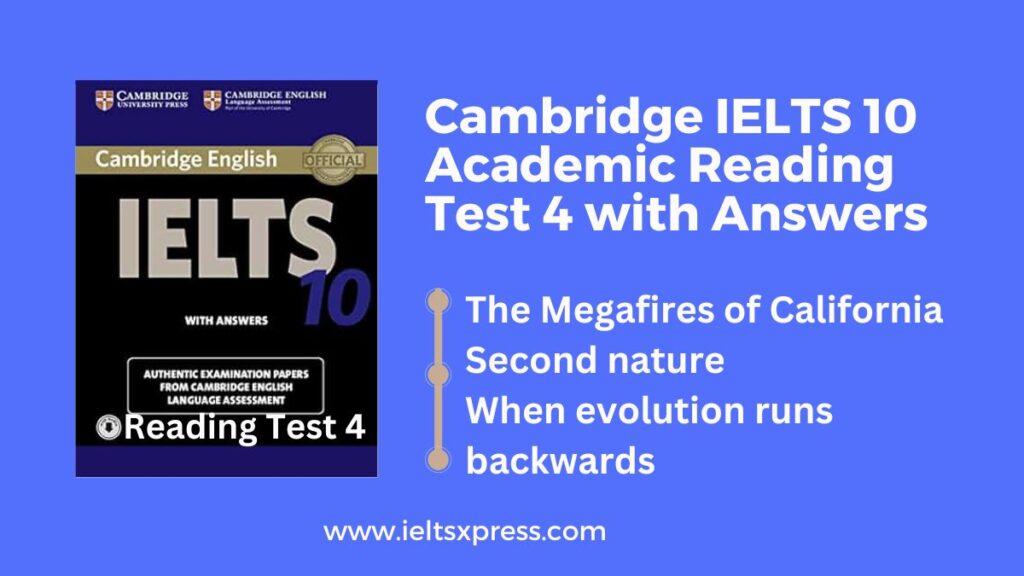Doctors Rights and Drinks IELTS Reading Passage with Answers
READING PASSAGE 3
You should spend about 20 minutes on Questions 27-40 which are based on Reading Passage 3 below.
Doctor’s Rights and Drinks
New Yorker John Davin started his campaign for election to Congress on 26th of September 1922. Actually, he was not a politician, but a doctor who practiced in a local city for 40 years at the top of his profession. Davin and other doctors with the same opinions were faced with the task of arguing their cases in front of the people. Also, they made a new political party, the Medical Rights League, and decided that Davin should run as a candidate for the coming election. What did they want? Beer, or more precisely, a doctor who had the right to prescribe it.
The Congress had legislated the law prohibiting the sale of alcohol in January 1920. The aim was to transform a nation of drinkers and gamblers into one of hard-working, law-abiding, teetotal citizens. It was now illegal to sell or buy a drink that included more than 0.5 per cent alcohol “for beverage purpose.” Only medical alcohol was allowed, but the conditions were so strict. Doctors could prescribe “liquor” when there was a “need to afford relief from a known ailment”. Patients could not have more than a pint of liquor “within 10 days at any time”. Doctors who needed to prescribe alcohol were approved for a permit. But the current law said nothing about beer, traditional alcohol for ailments from anaemia to anthrax. So, could they prescribe beer or not?
As doctors were requesting permission to prescribe beer, someone had to make a decision. That person was Attorney General Mitchell Palmer, a staunch supporter of Prohibition. To the delight of doctors and dismay of prohibitionists, he urged “it was not the purpose of Congress to prohibit the use of liquor for non-beverage usages.” The Congress accepted medicinal alcohol for non-beverage usages. It was for “beer and other malt liquors.”
The Prohibitionists were very enraged. They had suspicions that doctors were in league with the brewers and that their intentions were more to disrupt Prohibition than for medicinal purposes. Although brandy and whisky might have some medicinal advantages, in their view, beer was not needed at pharmacies. Congressman Andrew Volstead, who drafted the National Prohibition Act, criticized the decision saying “It is not a worthy argument that beer is medicine,” “Everything in beer except the alcohol is similar to the bears that can be bought without any prescription.” He immediately set up a supplementary bill that would further restrict medicinal alcohol and ban “medical beer” altogether.
Now, it was the doctors’ turn to be infuriated. How dare politicians presume to tell doctors what sort of things they could prescribe or how much. The merits of medicinal alcohol were suddenly a topic of national debate. For a couple of decades, doctors had been divided on the issue. Many insisted it was a treatment for all manners of disease. Others removed a worthless remedy left from the past. The American Medical Association (AMA), in 1917, denied the medicinal usage of alcohol, “Its value in therapeutics as a tonic, stimulant or food has no scientific basis.”
However, as Prohibition hit home, doctors’ enthusiasm for alcohol improved. Articles admiring beer, wine and whisky spread among medical journals. One doctor suggested champagne worked wonders in cases of scarlet fever. Beer was warranted to treat sleeplessness. One of the US’s top doctors even insisted that when children with diphtheria developed secondary infections, alcohol could save them.
According to JAMA, the report said, “Impressive particularly was the sincerity of the belief of a lot of physicians in the therapeutic effect of whisky within a limited number of diseases.” “But equally impressive was the expressed belief of a limited number of physicians of necessity within a lot of diseases.” The contents ran from anaemia to uraemia, including influenza and indigestion, cancer, colds and heart disease.
Questions 27-33
Do the following statements reflect the claims of the writer in Reading Passage 3?
In boxes 27-33 on your answer sheet, write
YES if the statement reflects the opinion of the writer
NO if the statement contradicts the opinion of the writer
NOT GIVEN if it is impossible to say what the writer thinks about this
27 John Davin has been ready for the election to Congress.
28 The Medical Rights League was made to support the right to prescribe beer by Davin and like-minded doctors.
29 It was illegal to sell or buy a beverage that contained over 0.5 per cent alcohol.
30 Congress only granted beer as medical alcohol.
31 As beer might have some benefit for medicinal use, it was in a pharmacy.
32 The American Medical Association (AMA) has funded a scientific basis.
33 If children have diphtheria, alcohol may cure them.
Questions 34-35
Choose the appropriate letters A-D and write them in boxes 34-35 on your answer sheet.
34 In 1922, the reason John Davin began a campaign
A was against beer and other malt liquors.
B was to assert a doctor’s right to prescribe beer.
C was for the Medical Rights League’s duty.
D was to oppose strong-minded politicians.
35 In 1917, the American Medical Association (AMA)
A decided beer is a worthless remedy.
B declared beer has an effect as a tonic.
C decided beer won’t be any evidence of a medical basis.
D assisted a patient with cancer.
Questions 36-39
Complete the summary below.
Choose ONE Word from Reading Passage 3 for each answer.
Write your answers in boxes 36-39 on your answer sheet.
Once prohibition affected homes, doctors stimulated interests in 36 _________ Besides, as doctors affirmed the effects of alcohol, beer was guaranteed to cure 37_________ When children with 38_________ transferred dual-infections, alcohol could save them. According to 39_________, most physicians believed the effects of therapeutic usage of whisky in the treatment of a limited number of diseases to be remarkably impressive.
Question 40
Choose the appropriate letter A-D and write it in box 40 on your answer sheet.
This text is taken from
A a medical textbook for a beginner.
B a critical research of the scientific basis of a beverage.
Ca magazine article about alcohol issues.
D a document against government prohibition.
Doctor’s Rights and Drinks IELTS Reading Answers
Practice with Expert IELTS Tutors Online
Apply Code "IELTSXPRESS20" To Get 20% off on IELTS Mock Test
27. NOT GIVEN
28. YES
29. YES
30. NO
31. NO
32. NOT GIVEN
33. YES
34. B
35. C
36. alcohol
37. sleeplessness
38. diphtheria
39. JAMA
40. C
ieltsxpress.com
Also Check: Ancient People in Sahara IELTS Reading Answers




